2013 FORD F SERIES MOTORHOME AND COMMERCIAL CHASSIS coolant temperature
[x] Cancel search: coolant temperaturePage 6 of 157
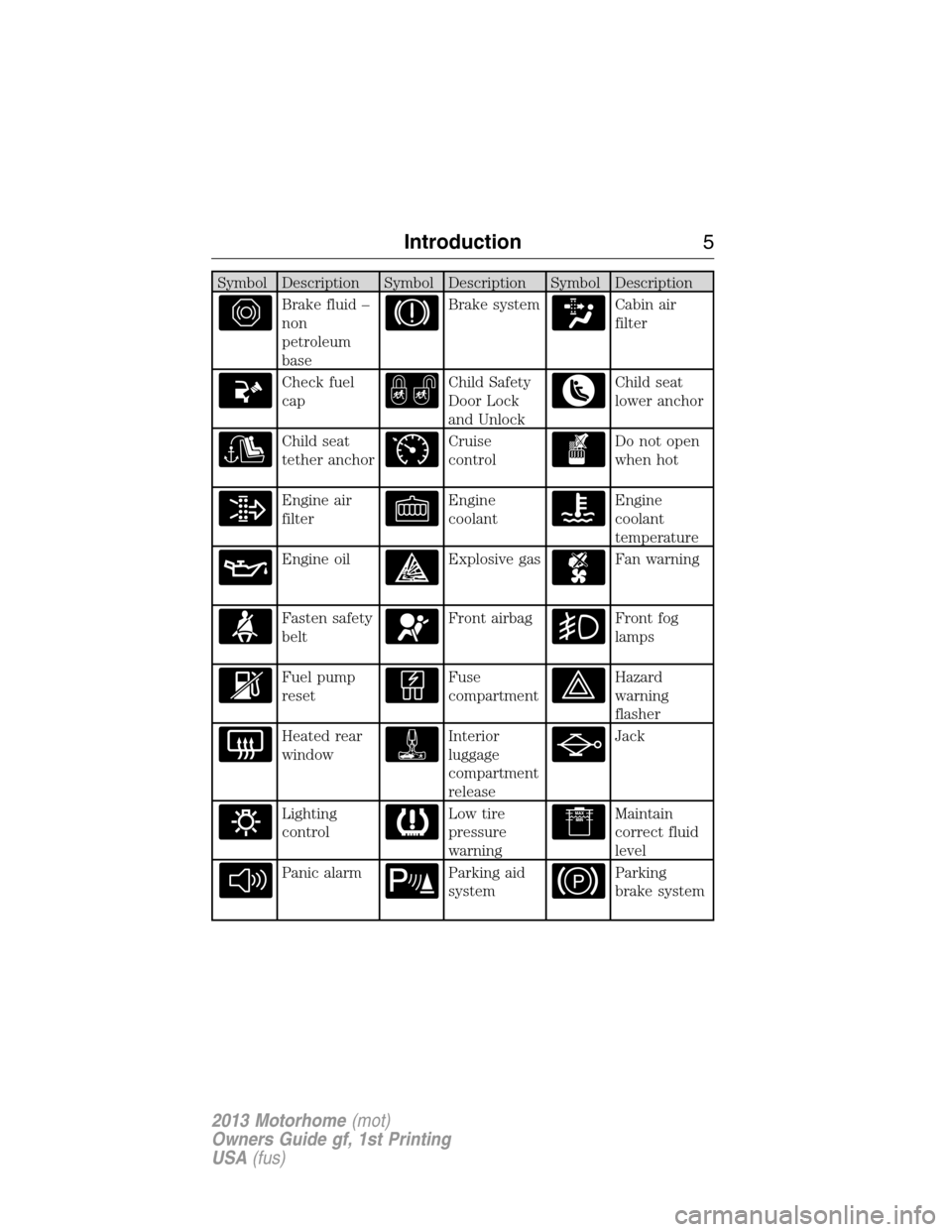
Symbol Description Symbol Description Symbol Description
Brake fluid –
non
petroleum
baseBrake systemCabin air
filter
Check fuel
capChild Safety
Door Lock
and UnlockChild seat
lower anchor
Child seat
tether anchorCruise
controlDo not open
when hot
Engine air
filterEngine
coolantEngine
coolant
temperature
Engine oilExplosive gasFan warning
Fasten safety
beltFront airbagFront fog
lamps
Fuel pump
resetFuse
compartmentHazard
warning
flasher
Heated rear
windowInterior
luggage
compartment
releaseJack
Lighting
controlLow tire
pressure
warningMaintain
correct fluid
level
Panic alarmParking aid
systemParking
brake system
Introduction5
2013 Motorhome(mot)
Owners Guide gf, 1st Printing
USA(fus)
Page 17 of 157
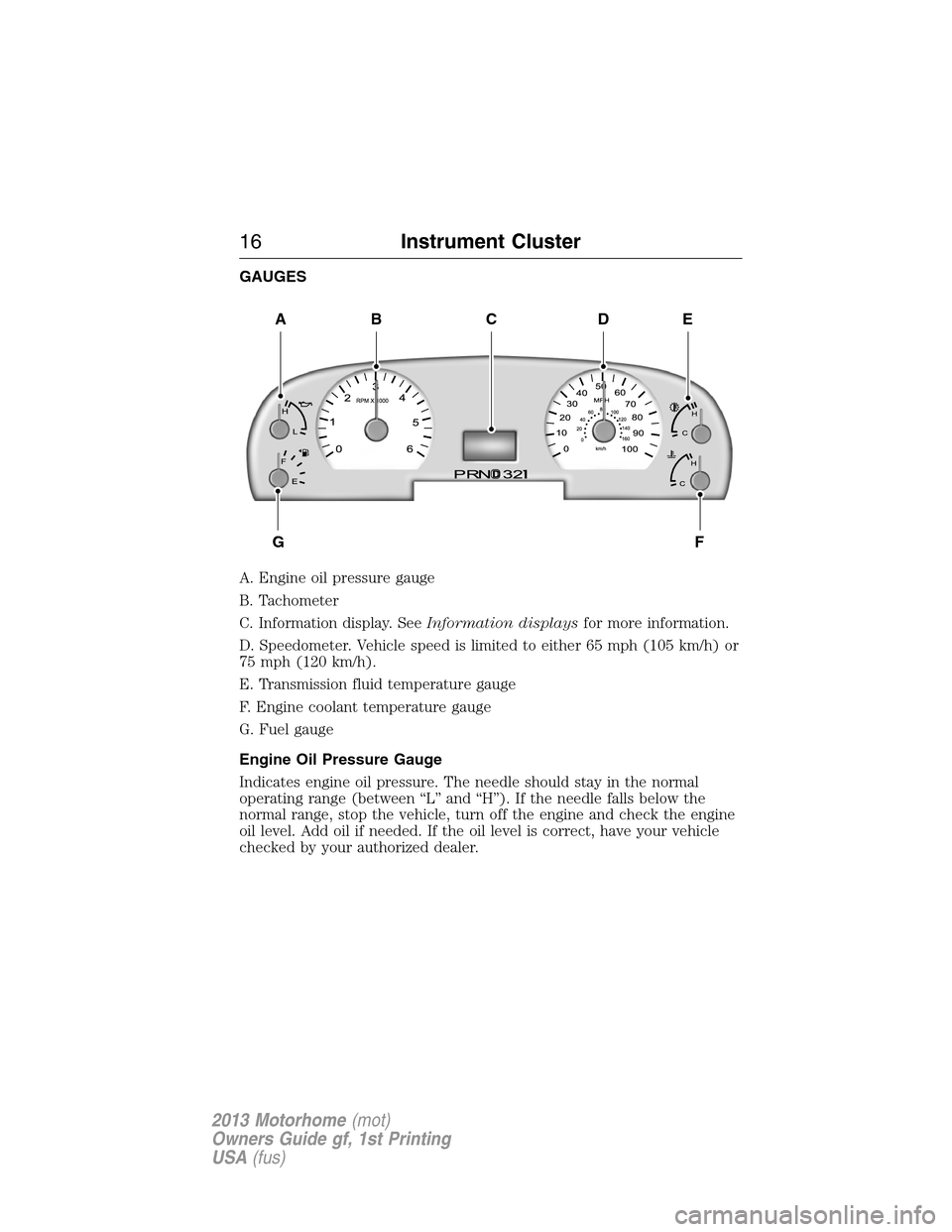
GAUGES
A. Engine oil pressure gauge
B. Tachometer
C. Information display. SeeInformation displaysfor more information.
D. Speedometer. Vehicle speed is limited to either 65 mph (105 km/h) or
75 mph (120 km/h).
E. Transmission fluid temperature gauge
F. Engine coolant temperature gauge
G. Fuel gauge
Engine Oil Pressure Gauge
Indicates engine oil pressure. The needle should stay in the normal
operating range (between “L” and “H”). If the needle falls below the
normal range, stop the vehicle, turn off the engine and check the engine
oil level. Add oil if needed. If the oil level is correct, have your vehicle
checked by your authorized dealer.
ABDEC
GF
16Instrument Cluster
2013 Motorhome(mot)
Owners Guide gf, 1st Printing
USA(fus)
Page 18 of 157
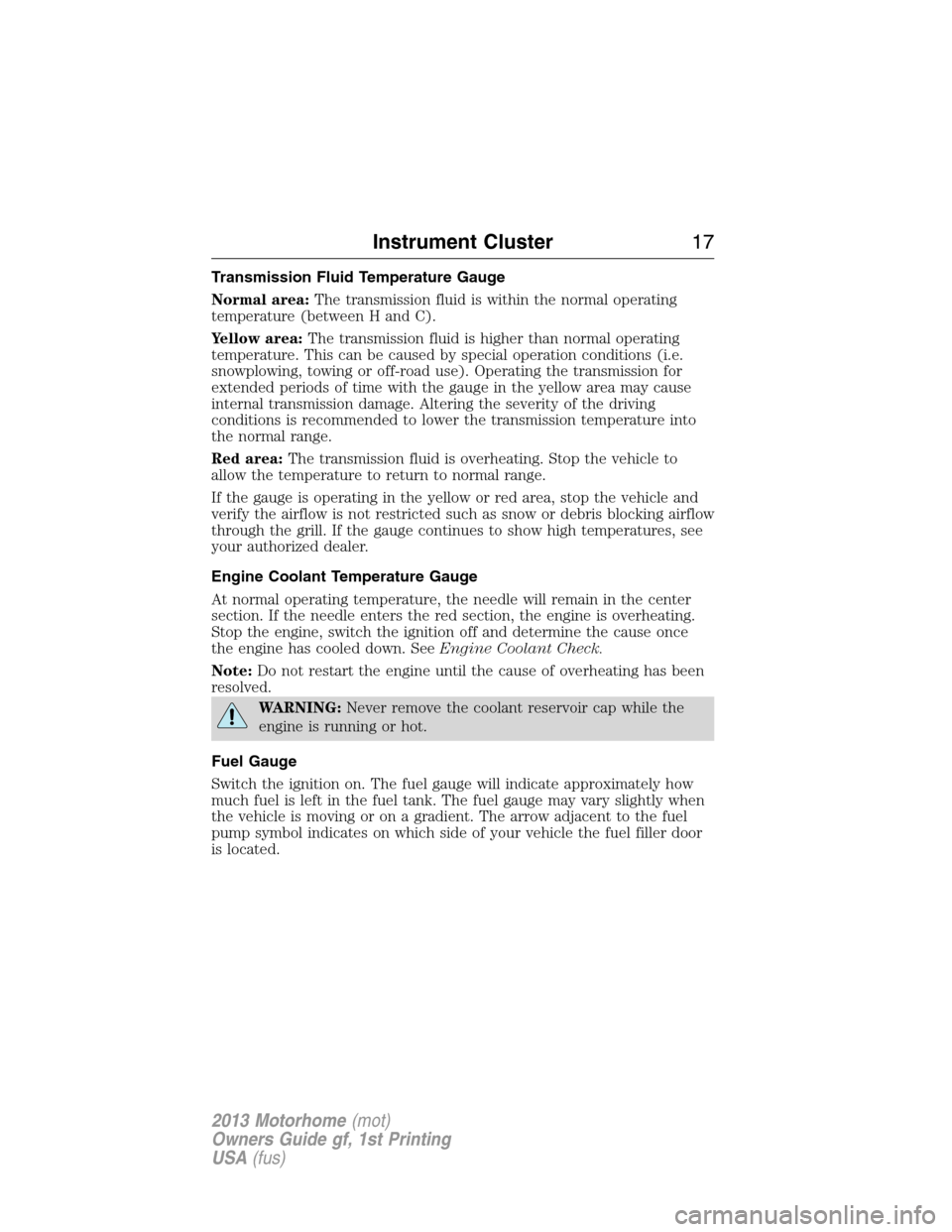
Transmission Fluid Temperature Gauge
Normal area:The transmission fluid is within the normal operating
temperature (between H and C).
Yellow area:The transmission fluid is higher than normal operating
temperature. This can be caused by special operation conditions (i.e.
snowplowing, towing or off-road use). Operating the transmission for
extended periods of time with the gauge in the yellow area may cause
internal transmission damage. Altering the severity of the driving
conditions is recommended to lower the transmission temperature into
the normal range.
Red area:The transmission fluid is overheating. Stop the vehicle to
allow the temperature to return to normal range.
If the gauge is operating in the yellow or red area, stop the vehicle and
verify the airflow is not restricted such as snow or debris blocking airflow
through the grill. If the gauge continues to show high temperatures, see
your authorized dealer.
Engine Coolant Temperature Gauge
At normal operating temperature, the needle will remain in the center
section. If the needle enters the red section, the engine is overheating.
Stop the engine, switch the ignition off and determine the cause once
the engine has cooled down. SeeEngine Coolant Check.
Note:Do not restart the engine until the cause of overheating has been
resolved.
WARNING:Never remove the coolant reservoir cap while the
engine is running or hot.
Fuel Gauge
Switch the ignition on. The fuel gauge will indicate approximately how
much fuel is left in the fuel tank. The fuel gauge may vary slightly when
the vehicle is moving or on a gradient. The arrow adjacent to the fuel
pump symbol indicates on which side of your vehicle the fuel filler door
is located.
Instrument Cluster17
2013 Motorhome(mot)
Owners Guide gf, 1st Printing
USA(fus)
Page 22 of 157
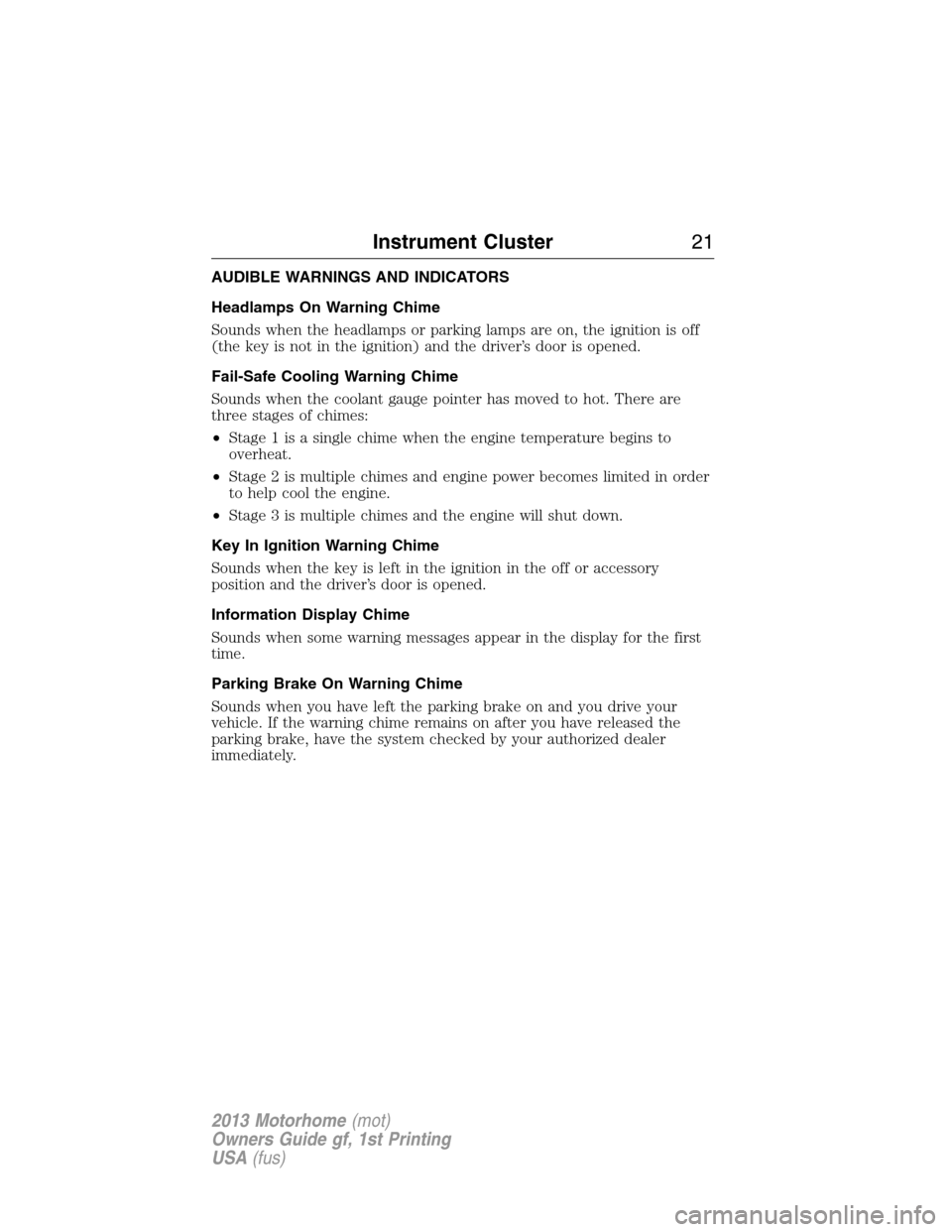
AUDIBLE WARNINGS AND INDICATORS
Headlamps On Warning Chime
Sounds when the headlamps or parking lamps are on, the ignition is off
(the key is not in the ignition) and the driver’s door is opened.
Fail-Safe Cooling Warning Chime
Sounds when the coolant gauge pointer has moved to hot. There are
three stages of chimes:
•Stage 1 is a single chime when the engine temperature begins to
overheat.
•Stage 2 is multiple chimes and engine power becomes limited in order
to help cool the engine.
•Stage 3 is multiple chimes and the engine will shut down.
Key In Ignition Warning Chime
Sounds when the key is left in the ignition in the off or accessory
position and the driver’s door is opened.
Information Display Chime
Sounds when some warning messages appear in the display for the first
time.
Parking Brake On Warning Chime
Sounds when you have left the parking brake on and you drive your
vehicle. If the warning chime remains on after you have released the
parking brake, have the system checked by your authorized dealer
immediately.
Instrument Cluster21
2013 Motorhome(mot)
Owners Guide gf, 1st Printing
USA(fus)
Page 26 of 157
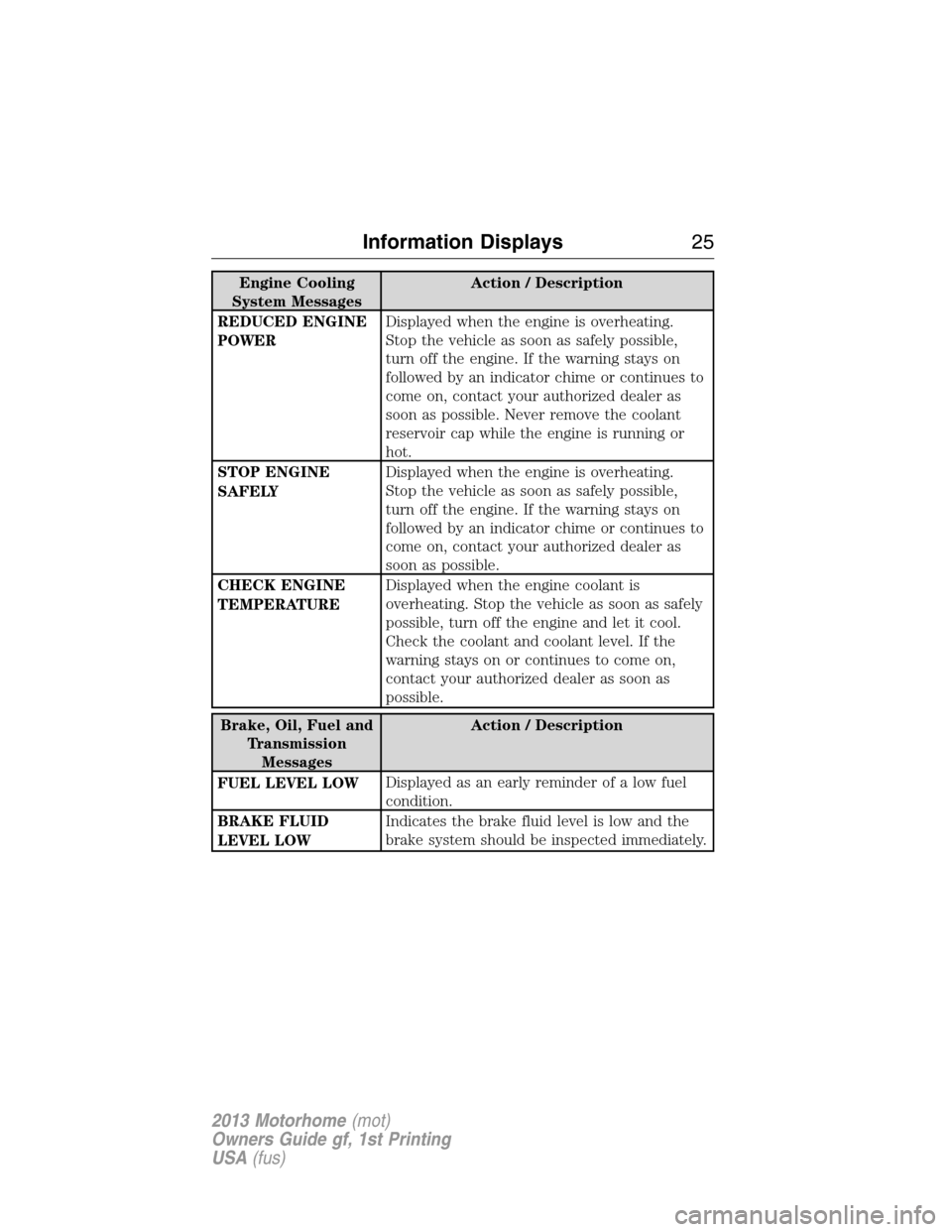
Engine Cooling
System MessagesAction / Description
REDUCED ENGINE
POWERDisplayed when the engine is overheating.
Stop the vehicle as soon as safely possible,
turn off the engine. If the warning stays on
followed by an indicator chime or continues to
come on, contact your authorized dealer as
soon as possible. Never remove the coolant
reservoir cap while the engine is running or
hot.
STOP ENGINE
SAFELYDisplayed when the engine is overheating.
Stop the vehicle as soon as safely possible,
turn off the engine. If the warning stays on
followed by an indicator chime or continues to
come on, contact your authorized dealer as
soon as possible.
CHECK ENGINE
TEMPERATUREDisplayed when the engine coolant is
overheating. Stop the vehicle as soon as safely
possible, turn off the engine and let it cool.
Check the coolant and coolant level. If the
warning stays on or continues to come on,
contact your authorized dealer as soon as
possible.
Brake, Oil, Fuel and
Transmission
MessagesAction / Description
FUEL LEVEL LOWDisplayed as an early reminder of a low fuel
condition.
BRAKE FLUID
LEVEL LOWIndicates the brake fluid level is low and the
brake system should be inspected immediately.
Information Displays25
2013 Motorhome(mot)
Owners Guide gf, 1st Printing
USA(fus)
Page 90 of 157
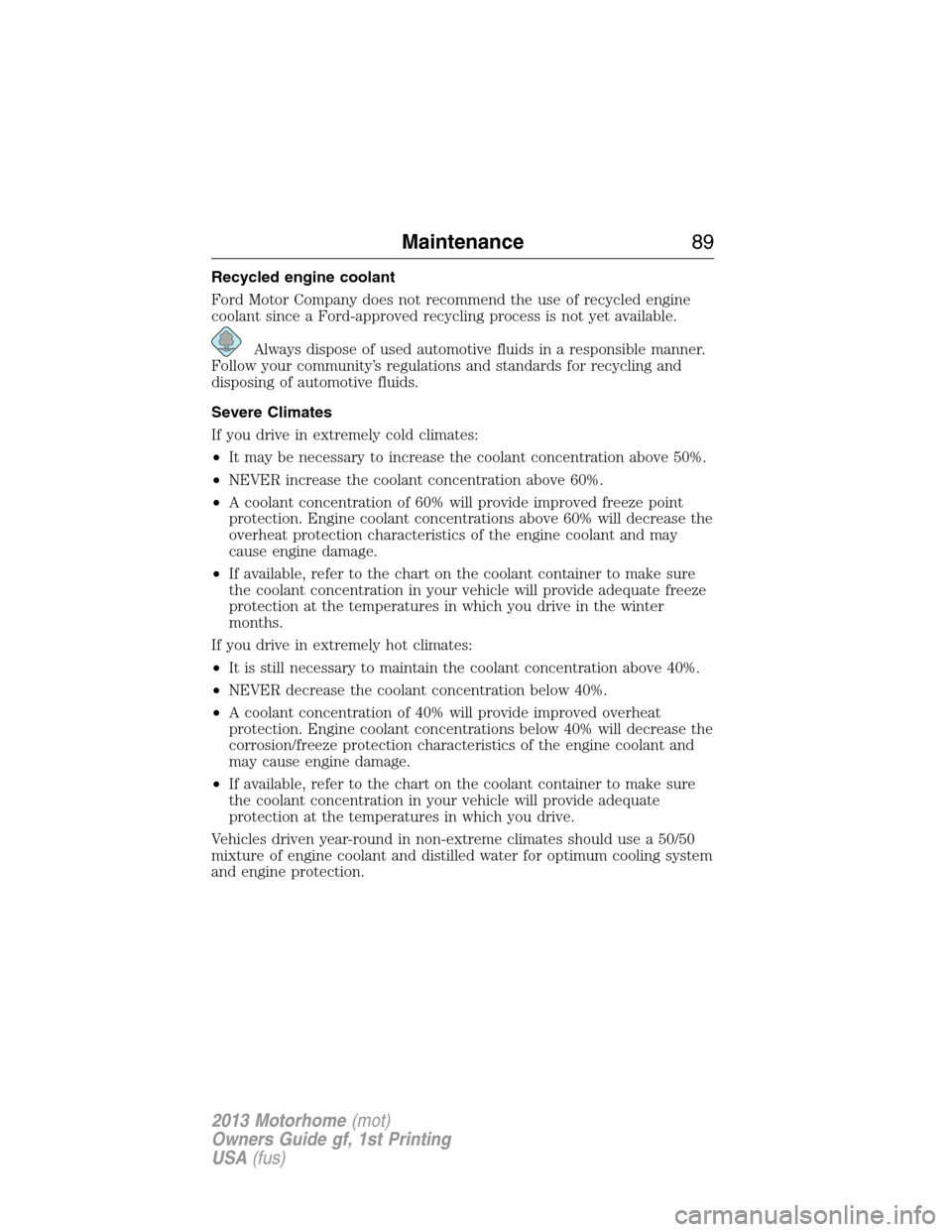
Recycled engine coolant
Ford Motor Company does not recommend the use of recycled engine
coolant since a Ford-approved recycling process is not yet available.
Always dispose of used automotive fluids in a responsible manner.
Follow your community’s regulations and standards for recycling and
disposing of automotive fluids.
Severe Climates
If you drive in extremely cold climates:
•It may be necessary to increase the coolant concentration above 50%.
•NEVER increase the coolant concentration above 60%.
•A coolant concentration of 60% will provide improved freeze point
protection. Engine coolant concentrations above 60% will decrease the
overheat protection characteristics of the engine coolant and may
cause engine damage.
•If available, refer to the chart on the coolant container to make sure
the coolant concentration in your vehicle will provide adequate freeze
protection at the temperatures in which you drive in the winter
months.
If you drive in extremely hot climates:
•It is still necessary to maintain the coolant concentration above 40%.
•NEVER decrease the coolant concentration below 40%.
•A coolant concentration of 40% will provide improved overheat
protection. Engine coolant concentrations below 40% will decrease the
corrosion/freeze protection characteristics of the engine coolant and
may cause engine damage.
•If available, refer to the chart on the coolant container to make sure
the coolant concentration in your vehicle will provide adequate
protection at the temperatures in which you drive.
Vehicles driven year-round in non-extreme climates should use a 50/50
mixture of engine coolant and distilled water for optimum cooling system
and engine protection.
Maintenance89
2013 Motorhome(mot)
Owners Guide gf, 1st Printing
USA(fus)
Page 91 of 157
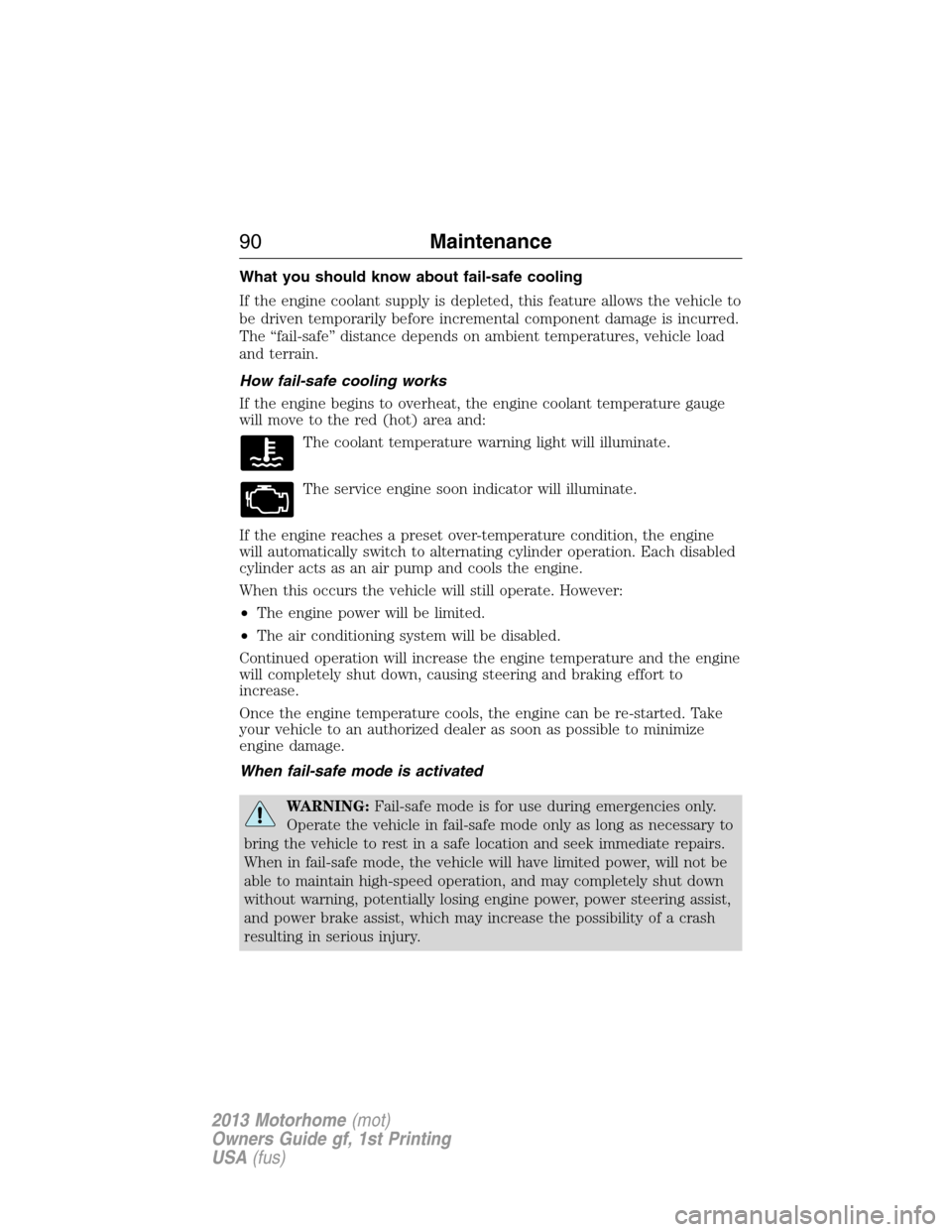
What you should know about fail-safe cooling
If the engine coolant supply is depleted, this feature allows the vehicle to
be driven temporarily before incremental component damage is incurred.
The “fail-safe” distance depends on ambient temperatures, vehicle load
and terrain.
How fail-safe cooling works
If the engine begins to overheat, the engine coolant temperature gauge
will move to the red (hot) area and:
The coolant temperature warning light will illuminate.
The service engine soon indicator will illuminate.
If the engine reaches a preset over-temperature condition, the engine
will automatically switch to alternating cylinder operation. Each disabled
cylinder acts as an air pump and cools the engine.
When this occurs the vehicle will still operate. However:
•The engine power will be limited.
•The air conditioning system will be disabled.
Continued operation will increase the engine temperature and the engine
will completely shut down, causing steering and braking effort to
increase.
Once the engine temperature cools, the engine can be re-started. Take
your vehicle to an authorized dealer as soon as possible to minimize
engine damage.
When fail-safe mode is activated
WARNING:Fail-safe mode is for use during emergencies only.
Operate the vehicle in fail-safe mode only as long as necessary to
bring the vehicle to rest in a safe location and seek immediate repairs.
When in fail-safe mode, the vehicle will have limited power, will not be
able to maintain high-speed operation, and may completely shut down
without warning, potentially losing engine power, power steering assist,
and power brake assist, which may increase the possibility of a crash
resulting in serious injury.
90Maintenance
2013 Motorhome(mot)
Owners Guide gf, 1st Printing
USA(fus)
Page 92 of 157
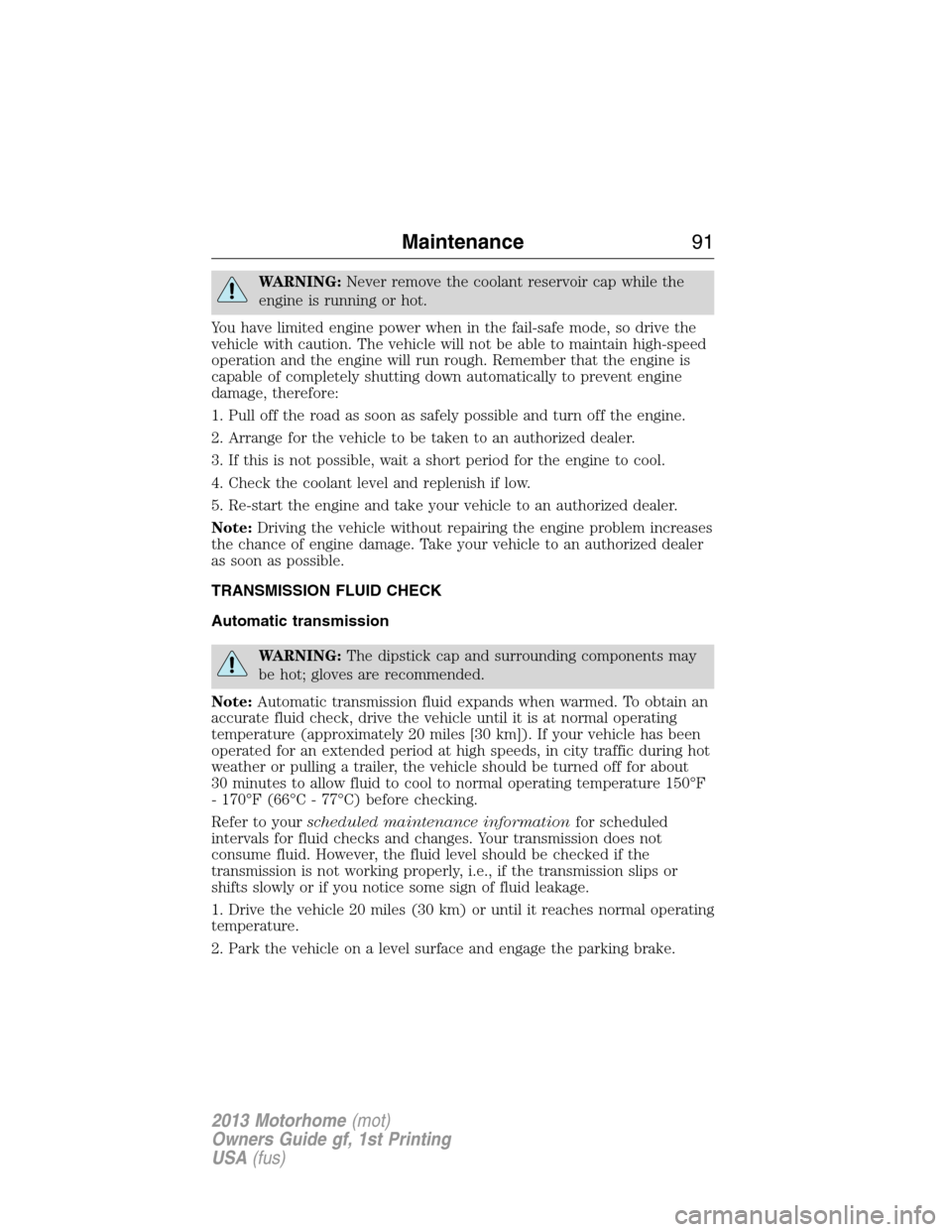
WARNING:Never remove the coolant reservoir cap while the
engine is running or hot.
You have limited engine power when in the fail-safe mode, so drive the
vehicle with caution. The vehicle will not be able to maintain high-speed
operation and the engine will run rough. Remember that the engine is
capable of completely shutting down automatically to prevent engine
damage, therefore:
1. Pull off the road as soon as safely possible and turn off the engine.
2. Arrange for the vehicle to be taken to an authorized dealer.
3. If this is not possible, wait a short period for the engine to cool.
4. Check the coolant level and replenish if low.
5. Re-start the engine and take your vehicle to an authorized dealer.
Note:Driving the vehicle without repairing the engine problem increases
the chance of engine damage. Take your vehicle to an authorized dealer
as soon as possible.
TRANSMISSION FLUID CHECK
Automatic transmission
WARNING:The dipstick cap and surrounding components may
be hot; gloves are recommended.
Note:Automatic transmission fluid expands when warmed. To obtain an
accurate fluid check, drive the vehicle until it is at normal operating
temperature (approximately 20 miles [30 km]). If your vehicle has been
operated for an extended period at high speeds, in city traffic during hot
weather or pulling a trailer, the vehicle should be turned off for about
30 minutes to allow fluid to cool to normal operating temperature 150°F
- 170°F (66°C - 77°C) before checking.
Refer to yourscheduled maintenance informationfor scheduled
intervals for fluid checks and changes. Your transmission does not
consume fluid. However, the fluid level should be checked if the
transmission is not working properly, i.e., if the transmission slips or
shifts slowly or if you notice some sign of fluid leakage.
1. Drive the vehicle 20 miles (30 km) or until it reaches normal operating
temperature.
2. Park the vehicle on a level surface and engage the parking brake.
Maintenance91
2013 Motorhome(mot)
Owners Guide gf, 1st Printing
USA(fus)